From aboard the International Space Station (ISS), astronauts constantly image various regions of the world, producing data that can then be cross-referenced over the years. Such a project exists for glaciers in Patagonia, South America, where climate change is significantly reducing the amount of freshwater ice available at high altitudes.
The image above showcases the Upsala glacier, which is a part of the North Patagonian Icefield, imaged this year from aboard the ISS by NASA astronauts. Compared to an image collected last year, the glacier has lost nearly 3 kilometers (2 miles) in length, reflecting a trend seen across South America.
Another hint that the calving process is occurring very fast is the color of Lago Argentino, the body of water immediately adjacent to the glacier's front. The greenish-gray color is produced by so-called rock flour, a mixture of thinly-ground rocks that a glacier removes from its path as it travels.
The surface of Lago Argentino is covered in foam following the collapse of a large chunk of ice from the Upsala glacier. ISS astronauts will continue to keep an eye on this region, and assess how climate change is driving South American glaciers ever backwards.

 14 DAY TRIAL //
14 DAY TRIAL //